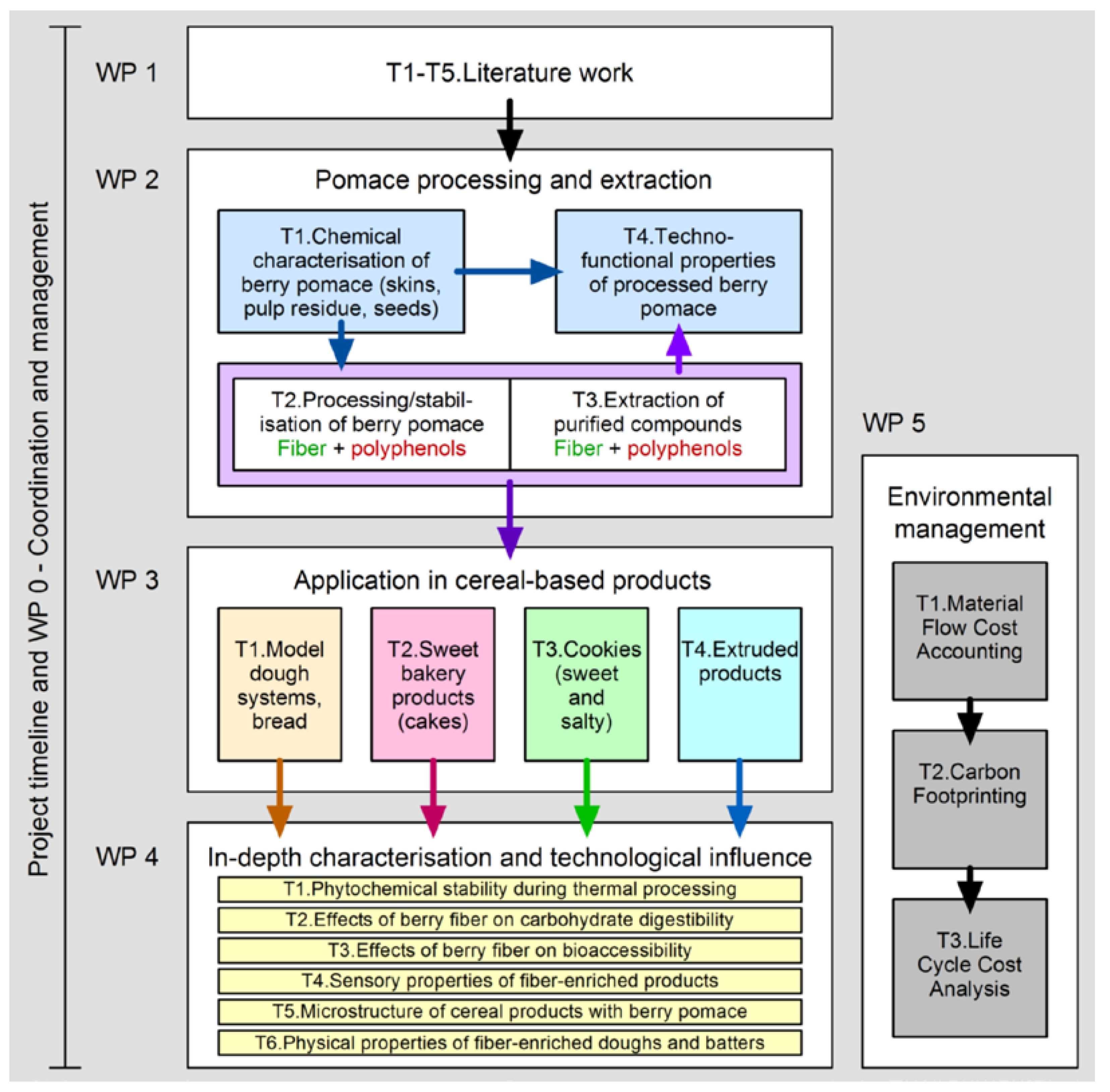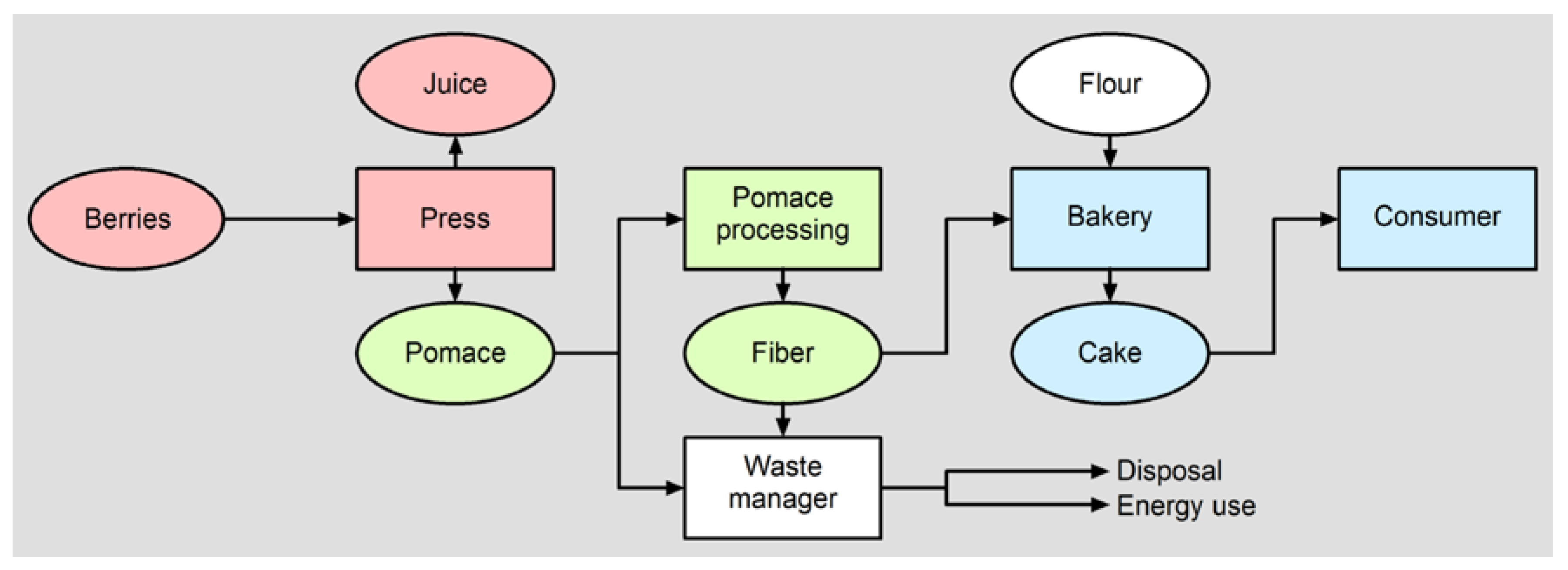Adding Value to Fruit Processing Waste: Innovative Ways to Incorporate Fibers from Berry Pomace in Baked and Extruded Cereal-based Foods—A SUSFOOD Project
Abstract
:1. Introduction
- Value can be added to the processing of soft berry fruits, e.g., blackcurrant and redcurrant, bilberry, chokeberry, or rowanberry (grapes are not topic of this project) when strategies and technologies are developed that make berry pomace usable as a food ingredient.
- Foods naturally rich or enriched with fiber and phytochemicals in the diet contribute to the health status of the consumer.
- As shown by Material Flow Cost Accounting and other methods, strategies for adding value to berry pomace have a sound economic and ecological basis.
2. The Proposed Research Agenda
2.1. General Targets

- We take advantage of pressing residues from berry processing that would otherwise be discarded, and
- We increase the nutritional value of the target products because of the transfer of its fiber and beneficial phytochemicals.
2.2. Specific Approaches of the Research Proposal
2.2.1. Pomace Processing and Extraction
2.2.2. Application of Processed Berry Pomace in Cereal-based Products
2.2.3. In-depth Characterization of Processed Berry Pomace and Technological Influence
2.2.4. Environmental Management

3. Discussion and Expected Output
Acknowledgments
Conflicts of Interest
References
- Oreopoulou, V.; Tzia, C. Utilization of plant by-products for the recovery of proteins, dietary fibers, antioxidants, and colorants. In Utilization of By-products and Treatment of Waste in the Food Industry; Oreopoulou, V., Russ, W., Eds.; Springer: New York, NY, USA, 2007; pp. 209–232. [Google Scholar]
- Pomerleau, J.; Lock, K.; Knai, C.; McKee, M. Interventions designed to increase adult fruit and vegetable intake can be effective: A systematic review of the literature. J. Nutr. 2005, 145, 2886–2495. [Google Scholar]
- Basu, A.; Du, M.; Leyva, M.J.; Sanchez, K.; Betts, N.M.; Wu, M.; Aston, C.E.; Lyons, T.J. Blueberries decrease cardiovascular risk factors in obese men and women with metabolic syndrome. J. Nutr. 2010, 140, 1582–1587. [Google Scholar] [CrossRef] [PubMed]
- Rodriguez-Mateos, A.; Rendeiro, C.; Bergillos-Meca, T.; Tabatabaee, S.; George, T.; Spencer, J.P. Intake and time dependence of blueberry flavonoid-induced improvements in vascular function: A randomized, controlled, double-blind, crossover intervention study with mechanistic insights into biological activity. Am. J. Clin. Nutr. 2013, 98, 1179–1191. [Google Scholar] [CrossRef] [PubMed]
- Vendrame, S.; Guglielmetti, S.; Riso, P.; Arioli, S.; Klimis-Zacas, D.; Porrini, M. Six-week consumption of a wild blueberry powder drink increases bifidobacteria in the human gut. J. Agric. Food Chem. 2011, 59, 12815–12820. [Google Scholar] [CrossRef] [PubMed]
- Liu, R.H. Potential synergy of phytochemicals in cancer prevention: Mechanism of action. J. Nutr. 2004, 134, 3479S–3485S. [Google Scholar] [PubMed]
- Van’t Riet, J. Sales effects of product health information at points of purchase: A systematic review. Public Health Nutr. 2012, 16, 418–429. [Google Scholar] [CrossRef] [PubMed]
- Boland, M.J.; Rae, A.N.; Vereijken, J.M.; Meuwissen, M.P.M.; Fischer, A.R.H.; van Boekel, M.A.J.S.; Rutherford, S.M.; Gruppen, H.; Moughan, P.J.; Hendriks, W.H. The future supply of animal-derived protein for human consumption. Trends Food Sci. Technol. 2013, 29, 62–73. [Google Scholar] [CrossRef]
- Manganaris, G.A.; Goulas, V.; Vicente, A.R.; Terry, L.A. Berry oxidants: Small fruits providing large benefits. J. Sci. Food Agric. 2014, 94, 825–833. [Google Scholar] [CrossRef] [PubMed]
- Khanal, R.C.; Howard, L.R.; Prior, R.L. Effect of heating on the stability of grape and blueberry pomace procyanidins and total anthocyans. Food Res. Int. 2010, 43, 1464–1469. [Google Scholar] [CrossRef]
- Rodriguez-Mateos, A.; Cifuentes-Gomez, T.; George, T.E.; Spencer, J.P.E. Impact of cooking, proving, and baking on the (poly)phenol content of wild blueberry. J. Agric. Food Chem. 2014, 62, 3979–3986. [Google Scholar] [CrossRef] [PubMed]
- Nawirska, A.; Kwasniewska, A. Dietary fibre fractions from fruit and vegetable processing waste. Food Chem. 2005, 91, 221–225. [Google Scholar] [CrossRef]
- Struck, S.; Gundel, L.; Zahn, S.; Rohm, H. Fiber enriched reduced sugar muffins made from iso-viscous batters. LWT Food Sci. Technol. 2016, 65, 23–38. [Google Scholar] [CrossRef]
- Kontogiorgos, V.; Dahunsi, O.S. Relaxation dynamics in hydrated gluten networks. J. Cereal Sci. 2014, 59, 101–108. [Google Scholar] [CrossRef]
- Trinh, L.; Lowe, T.; Campbell, G.M.; Withers, P.J.; Martin, P.J. Effect of sugar on bread dough aeration during mixing. J. Food Eng. 2015, 150, 9–18. [Google Scholar] [CrossRef]
- Rodríguez-García, J.; Salvador, A.; Hernando, I. Replacing fat and sugar with inulin in cakes: Bubble size distribution, physical, and sensory properties. Food Bioprocess Technol. 2014, 7, 964–974. [Google Scholar] [CrossRef]
- Zahn, S.; Forker, A.; Krügel, L.; Rohm, H. Combined use of rebaudioside A and fibres for partial sucrose replacement in muffins. LWT Food Sci. Technol. 2013, 50, 695–701. [Google Scholar] [CrossRef]
- Dehghan-Shoar, Z.; Mandimika, T.; Hardacre, A.K.; Reynolds, G.W.; Brennan, C.S. Lycopene bioaccessibility and starch digestibility for extruded snacks enriched with tomato derivatives. J. Agric. Food Chem. 2011, 59, 12047–12053. [Google Scholar] [CrossRef] [PubMed]
- Hedren, E.; Diaz, V.; Svanberg, U. Estimation of carotenoid accessibility from carrots determined by an in vitro digestion method. Eur. J. Clin. Nutr. 2002, 56, 425–430. [Google Scholar] [CrossRef] [PubMed]
- Foschia, M.; Peressini, D.; Sensidoni, A.; Brennan, M.A.; Brennan, C.S. Synergistic effect of different dietary fibres in pasta on in vitro starch digestion? Food Chem. 2015, 162, 245–250. [Google Scholar] [CrossRef] [PubMed]
- Tagliazucchi, D.; Verzelloni, E.; Bettolini, D.; Conte, A. In vitro bio-accessibility and antioxidant activity of grape polyphenols. Food Chem. 2010, 120, 599–606. [Google Scholar] [CrossRef]
- Palafox-Carlos, H.; Ayala-Zavala, J.F.; Gomzalez-Aguilar, G.A. The role of dietary fiber in the bioaccessibility and bioavailability of fruit and vegetable antioxidants. J. Food Sci. 2011, 76, R6–R15. [Google Scholar] [CrossRef] [PubMed]
- Plaza, M.; Turner, C. Pressurized hot water extraction of bioactives. Trends Anal. Chem. 2015, 71, 39–54. [Google Scholar] [CrossRef]
- Jumaah, F.; Sandahl, M.; Turner, C. Supercritical fluid extraction and chromatography of bilberries. J. Am. Oil Chem. Soc. 2015, 92, 1103–1111. [Google Scholar] [CrossRef] [PubMed]
- Laroze, L.E.; Diaz-Reinoso, B.; Moure, A.; Zuniga, M.E.; Dominguez, H. Extraction of antioxidants from several berries pressing wastes using conventional and supercritical solvents. Eur. Food Res. Technol. 2010, 231, 669–677. [Google Scholar] [CrossRef]
- Münch, S.; Günther, E. A systematic review of bioenergy life cycle assessments. Appl. Energy 2013, 36, 17–38. [Google Scholar] [CrossRef]
- Ekman, A.; Campos, M.; Lindahl, S.; Co, M.; Börjesson, P.; Nordberg Karlsson, E.; Turner, C. Bioresource utilization by sustainable technologies in new value-added biorefinery concepts—Two case studies from food and forest industry. J. Clean. Prod. 2013, 57, 46–58. [Google Scholar] [CrossRef]
© 2015 by the authors; licensee MDPI, Basel, Switzerland. This article is an open access article distributed under the terms and conditions of the Creative Commons Attribution license (http://creativecommons.org/licenses/by/4.0/).
Share and Cite
Rohm, H.; Brennan, C.; Turner, C.; Günther, E.; Campbell, G.; Hernando, I.; Struck, S.; Kontogiorgos, V. Adding Value to Fruit Processing Waste: Innovative Ways to Incorporate Fibers from Berry Pomace in Baked and Extruded Cereal-based Foods—A SUSFOOD Project. Foods 2015, 4, 690-697. https://doi.org/10.3390/foods4040690
Rohm H, Brennan C, Turner C, Günther E, Campbell G, Hernando I, Struck S, Kontogiorgos V. Adding Value to Fruit Processing Waste: Innovative Ways to Incorporate Fibers from Berry Pomace in Baked and Extruded Cereal-based Foods—A SUSFOOD Project. Foods. 2015; 4(4):690-697. https://doi.org/10.3390/foods4040690
Chicago/Turabian StyleRohm, Harald, Charles Brennan, Charlotta Turner, Edeltraud Günther, Grant Campbell, Isabel Hernando, Susanne Struck, and Vassilis Kontogiorgos. 2015. "Adding Value to Fruit Processing Waste: Innovative Ways to Incorporate Fibers from Berry Pomace in Baked and Extruded Cereal-based Foods—A SUSFOOD Project" Foods 4, no. 4: 690-697. https://doi.org/10.3390/foods4040690
APA StyleRohm, H., Brennan, C., Turner, C., Günther, E., Campbell, G., Hernando, I., Struck, S., & Kontogiorgos, V. (2015). Adding Value to Fruit Processing Waste: Innovative Ways to Incorporate Fibers from Berry Pomace in Baked and Extruded Cereal-based Foods—A SUSFOOD Project. Foods, 4(4), 690-697. https://doi.org/10.3390/foods4040690










